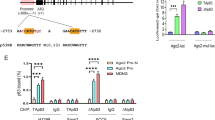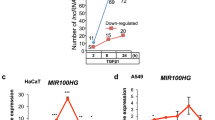Abstract
The transcription factor AP-1 plays key roles in tumorigenesis, by regulating a variety of protein-coding genes, implicated in multiple hallmarks of cancer. Among non-coding genes, no AP-1 target has been described yet in tumorigenesis. MicroRNAs (miRNAs) are negative post-transcriptional regulators of protein-coding genes. miRNA expression signatures are highly relevant in cancer and several tumor-associated miRNAs (oncomirs) play critical roles in oncogenesis. Here, we show that the miRNA miR-21, which represents the most frequently upregulated oncomir in solid tumors, is induced by AP-1 in response to RAS. By analyzing validated miR-21 targets, we have found that the tumor suppressors PTEN and PDCD4 are downregulated by RAS in an AP-1- and miR-21-dependent fashion. We further show that, given the role of PDCD4 as negative regulator of AP-1, the miR-21-mediated downregulation of PDCD4 is essential for the maximal induction of AP-1 activity in response to RAS. Our data reveal a novel mechanism of positive autoregulation of the AP-1 complex in RAS transformation and disclose the function of oncomirs as critical targets and regulators of AP-1 in tumorigenesis.
This is a preview of subscription content, access via your institution
Access options
Subscribe to this journal
Receive 50 print issues and online access
$259.00 per year
only $5.18 per issue
Buy this article
- Purchase on Springer Link
- Instant access to full article PDF
Prices may be subject to local taxes which are calculated during checkout









Similar content being viewed by others
References
Ancrile B, Lim KH, Counter CM . (2007). Oncogenic Ras-induced secretion of IL6 is required for tumorigenesis. Genes Dev 21: 1714–1719.
Asangani IA, Rasheed SA, Nikolova DA, Leupold JH, Colburn NH, Post S et al. (2008). MicroRNA-21 (miR-21) post-transcriptionally downregulates tumor suppressor Pdcd4 and stimulates invasion, intravasation and metastasis in colorectal cancer. Oncogene 27: 2128–2136.
Bahassi el M, Karyala S, Tomlinson CR, Sartor MA, Medvedovic M, Hennigan RF . (2004). Critical regulation of genes for tumor cell migration by AP-1. Clin Exp Metastasis 21: 293–304.
Bakiri L, Lallemand D, Bossy-Wetzel E, Yaniv M . (2000). Cell cycle-dependent variations in c-Jun and JunB phosphorylation: a role in the control of cyclin D1 expression. EMBO J 19: 2056–2068.
Bakiri L, Matsuo K, Wisniewska M, Wagner EF, Yaniv M . (2002). Promoter specificity and biological activity of tethered AP-1 dimers. Mol Cell Biol 22: 4952–4964.
Bartel DP . (2004). MicroRNAs: genomics, biogenesis, mechanism, and function. Cell 116: 281–297.
Bitomsky N, Bohm M, Klempnauer KH . (2004). Transformation suppressor protein Pdcd4 interferes with JNK-mediated phosphorylation of c-Jun and recruitment of the coactivator p300 by c-Jun. Oncogene 23: 7484–7493.
Cai X, Hagedorn CH, Cullen BR . (2004). Human microRNAs are processed from capped, polyadenylated transcripts that can also function as mRNAs. RNA 10: 1957–1966.
Calin GA, Croce CM . (2006). MicroRNA signatures in human cancers. Nat Rev Cancer 6: 857–866.
Casalino L, De Cesare D, Verde P . (2003). Accumulation of Fra-1 in ras-transformed cells depends on both transcriptional autoregulation and MEK-dependent posttranslational stabilization. Mol Cell Biol 23: 4401–4415.
Chan JA, Krichevsky AM, Kosik KS . (2005). MicroRNA-21 is an antiapoptotic factor in human glioblastoma cells. Cancer Res 65: 6029–6033.
Cimmino A, Calin GA, Fabbri M, Iorio MV, Ferracin M, Shimizu M et al. (2005). miR-15 and miR-16 induce apoptosis by targeting BCL2. Proc Natl Acad Sci USA 102: 13944–13949.
Corsten MF, Miranda R, Kasmieh R, Krichevsky AM, Weissleder R, Shah K . (2007). MicroRNA-21 knockdown disrupts glioma growth in vivo and displays synergistic cytotoxicity with neural precursor cell delivered S-TRAIL in human gliomas. Cancer Res 67: 8994–9000.
Davis BN, Hilyard AC, Lagna G, Hata A . (2008). SMAD proteins control DROSHA-mediated microRNA maturation. Nature 454: 56–61.
De Vita G, Bauer L, da Costa VM, De Felice M, Baratta MG, De Menna M et al. (2005). Dose-dependent inhibition of thyroid differentiation by RAS oncogenes. Mol Endocrinol 19: 76–89.
Dorrello NV, Peschiaroli A, Guardavaccaro D, Colburn NH, Sherman NE, Pagano M . (2006). S6K1- and betaTRCP-mediated degradation of PDCD4 promotes protein translation and cell growth. Science 314: 467–471.
Eferl R, Wagner EF . (2003). AP-1: a double-edged sword in tumorigenesis. Nat Rev Cancer 3: 859–868.
Elmen J, Lindow M, Schutz S, Lawrence M, Petri A, Obad S et al. (2008). LNA-mediated microRNA silencing in non-human primates. Nature 452: 896–899.
Esquela-Kerscher A, Slack FJ . (2006). Oncomirs - microRNAs with a role in cancer. Nat Rev Cancer 6: 259–269.
Frankel LB, Christoffersen NR, Jacobsen A, Lindow M, Krogh A, Lund AH . (2008). Programmed cell death 4 (PDCD4) is an important functional target of the microRNA miR-21 in breast cancer cells. J Biol Chem 283: 1026–1033.
Fujita S, Iba H . (2008). Putative promoter regions of miRNA genes involved in evolutionarily conserved regulatory systems among vertebrates. Bioinformatics 24: 303–308.
Fujita S, Ito T, Mizutani T, Minoguchi S, Yamamichi N, Sakurai K et al. (2008). miR-21 Gene expression triggered by AP-1 is sustained through a double-negative feedback mechanism. J Mol Biol 378: 492–504.
Fulci V, Chiaretti S, Goldoni M, Azzalin G, Carucci N, Tavolaro S et al. (2007). Quantitative technologies establish a novel microRNA profile of chronic lymphocytic leukemia. Blood 109: 4944–4951.
He H, Jazdzewski K, Li W, Liyanarachchi S, Nagy R, Volinia S et al. (2005). The role of microRNA genes in papillary thyroid carcinoma. Proc Natl Acad Sci USA 102: 19075–19080.
He X, He L, Hannon GJ . (2007). The guardian's little helper: microRNAs in the p53 tumor suppressor network. Cancer Res 67: 11099–11101.
Hettinger K, Vikhanskaya F, Poh MK, Lee MK, de Belle I, Zhang JT et al. (2007). c-Jun promotes cellular survival by suppression of PTEN. Cell Death Differ 14: 218–229.
Iorio MV, Ferracin M, Liu CG, Veronese A, Spizzo R, Sabbioni S et al. (2005). MicroRNA gene expression deregulation in human breast cancer. Cancer Res 65: 7065–7070..
Jansen AP, Camalier CE, Colburn NH . (2005). Epidermal expression of the translation inhibitor programmed cell death 4 suppresses tumorigenesis. Cancer Res 65: 6034–6041.
Landgraf P, Rusu M, Sheridan R, Sewer A, Iovino N, Aravin A et al. (2007). A mammalian microRNA expression atlas based on small RNA library sequencing. Cell 129: 1401–1414.
Leupold JH, Yang HS, Colburn NH, Asangani I, Post S, Allgayer H . (2007). Tumor suppressor Pdcd4 inhibits invasion/intravasation and regulates urokinase receptor (u-PAR) gene expression via Sp-transcription factors. Oncogene 26: 4550–4562.
Lim LP, Lau NC, Garrett-Engele P, Grimson A, Schelter JM, Castle J et al. (2005). Microarray analysis shows that some microRNAs downregulate large numbers of target mRNAs. Nature 433: 769–773.
Loffler D, Brocke-Heidrich K, Pfeifer G, Stocsits C, Hackermuller J, Kretzschmar AK et al. (2007). Interleukin-6 dependent survival of multiple myeloma cells involves the Stat3-mediated induction of microRNA-21 through a highly conserved enhancer. Blood 110: 1330–1333.
Lu Z, Liu M, Stribinskis V, Klinge CM, Ramos KS, Colburn NH et al. (2008). MicroRNA-21 promotes cell transformation by targeting the programmed cell death 4 gene. Oncogene 27: 4373–4379.
Mechta F, Lallemand D, Pfarr CM, Yaniv M . (1997). Transformation by ras modifies AP1 composition and activity. Oncogene 14: 837–847.
Meng F, Henson R, Lang M, Wehbe H, Maheshwari S, Mendell JT et al. (2006). Involvement of human micro-RNA in growth and response to chemotherapy in human cholangiocarcinoma cell lines. Gastroenterology 130: 2113–2129.
Meng F, Henson R, Wehbe-Janek H, Ghoshal K, Jacob ST, Patel T . (2007). MicroRNA-21 regulates expression of the PTEN tumor suppressor gene in human hepatocellular cancer. Gastroenterology 133: 647–658.
O’Donnell KA, Wentzel EA, Zeller KI, Dang CV, Mendell JT . (2005). c-Myc-regulated microRNAs modulate E2F1 expression. Nature 435: 839–843.
Olive M, Krylov D, Echlin DR, Gardner K, Taparowsky E, Vinson C . (1997). A dominant negative to activation protein-1 (AP1) that abolishes DNA binding and inhibits oncogenesis. J Biol Chem 272: 18586–18594.
Ozanne BW, Spence HJ, McGarry LC, Hennigan RF . (2007). Transcription factors control invasion: AP-1 the first among equals. Oncogene 26: 1–10.
Pallante P, Visone R, Ferracin M, Ferraro A, Berlingieri MT, Troncone G et al. (2006). MicroRNA deregulation in human thyroid papillary carcinomas. Endocr Relat Cancer 13: 497–508.
Shaulian E, Karin M . (2002). AP-1 as a regulator of cell life and death. Nat Cell Biol 4: E131–E136.
Si ML, Zhu S, Wu H, Lu Z, Wu F, Mo YY . (2007). miR-21-mediated tumor growth. Oncogene 26: 2799–2803.
Vallone D, Battista S, Pierantoni GM, Fedele M, Casalino L, Santoro M et al. (1997). Neoplastic transformation of rat thyroid cells requires the junB and fra-1 gene induction, which is dependent on the HMGI-C gene product. EMBO J 16: 5310–5321.
Vasudevan KM, Burikhanov R, Goswami A, Rangnekar VM . (2007). Suppression of PTEN expression is essential for antiapoptosis and cellular transformation by oncogenic Ras. Cancer Res 67: 10343–10350.
Volinia S, Calin GA, Liu CG, Ambs S, Cimmino A, Petrocca F et al. (2006). A microRNA expression signature of human solid tumors defines cancer gene targets. Proc Natl Acad Sci USA 103: 2257–2261.
Wang Q, Sun Z, Yang HS . (2007). Downregulation of tumor suppressor Pdcd4 promotes invasion and activates both beta-catenin/Tcf and AP-1-dependent transcription in colon carcinoma cells. Oncogene 27: 1527–1535.
Yang HS, Jansen AP, Komar AA, Zheng X, Merrick WC, Costes S et al. (2003a). The transformation suppressor Pdcd4 is a novel eukaryotic translation initiation factor 4A binding protein that inhibits translation. Mol Cell Biol 23: 26–37.
Yang HS, Knies JL, Stark C, Colburn NH . (2003b). Pdcd4 suppresses tumor phenotype in JB6 cells by inhibiting AP-1 transactivation. Oncogene 22: 3712–3720.
Yang HS, Matthews CP, Clair T, Wang Q, Baker AR, Li CC et al. (2006). Tumorigenesis suppressor Pdcd4 down-regulates mitogen-activated protein kinase kinase kinase kinase 1 expression to suppress colon carcinoma cell invasion. Mol Cell Biol 26: 1297–1306.
Young MR, Li JJ, Rincon M, Flavell RA, Sathyanarayana BK, Hunziker R et al. (1999). Transgenic mice demonstrate AP-1 (activator protein-1) transactivation is required for tumor promotion. Proc Natl Acad Sci USA 96: 9827–9832.
Yu SL, Chen HY, Chang GC, Chen CY, Chen HW, Singh S et al. (2008). MicroRNA signature predicts survival and relapse in lung cancer. Cancer Cell 13: 48–57.
Zhu S, Si ML, Wu H, Mo YY . (2007). MicroRNA-21 targets the tumor suppressor gene tropomyosin 1 (TPM1). J Biol Chem 282: 14328–14336.
Zhu S, Wu H, Wu F, Nie D, Sheng S, Mo YY . (2008). MicroRNA-21 targets tumor suppressor genes in invasion and metastasis. Cell Res 18: 350–359.
Acknowledgements
We thank Robert Hennigan (University of Cincinnati, USA), Nancy Colburn (NCI, NIH, USA), Anders Lund (University of Copenhagen, Denmark) and Hideo Iba (University of Tokyo, Japan) for expression and reporter constructs. We also thank Floriana Della Ragione and Ingram Iaccarino (IGB) for technical help and critical reading of the paper. This work was supported by grants from AIRC (Associazione Italiana per la Ricerca sul Cancro) and AICR (Association for International Cancer Research, UK) to PV and AIRC and EU-Project-SIROCCO (Grant LSHG-CT-2006-037900) to RDL.
Author information
Authors and Affiliations
Corresponding author
Additional information
Supplementary Information accompanies the paper on the Oncogene website (http://www.nature.com/onc)
Supplementary information
Rights and permissions
About this article
Cite this article
Talotta, F., Cimmino, A., Matarazzo, M. et al. An autoregulatory loop mediated by miR-21 and PDCD4 controls the AP-1 activity in RAS transformation. Oncogene 28, 73–84 (2009). https://doi.org/10.1038/onc.2008.370
Received:
Revised:
Accepted:
Published:
Issue Date:
DOI: https://doi.org/10.1038/onc.2008.370
Keywords
This article is cited by
-
Role of miRNA-21 in radiation-induced heart disease
Oncology and Translational Medicine (2023)
-
Inhibition of germinal vesicle breakdown using IBMX increases microRNA-21 in the porcine oocyte
Reproductive Biology and Endocrinology (2020)
-
An autoregulatory feedback loop of miR-21/VMP1 is responsible for the abnormal expression of miR-21 in colorectal cancer cells
Cell Death & Disease (2020)
-
Transregulation of microRNA miR-21 promoter by AP-1 transcription factor in cervical cancer cells
Cancer Cell International (2019)
-
miR-21 promotes EGF-induced pancreatic cancer cell proliferation by targeting Spry2
Cell Death & Disease (2018)



